Projected 21st Century Increased Water Stress in the Athabasca River Basin: The Center of Canada’s Oil Sands Industry
Abstract
1. Introduction
2. Regional Setting, Materials and Methods
2.1. Regional Setting
2.2. Data Sources
2.3. Calculations and Statistical Methods
3. Results
3.1. Historical Simulations
3.2. Projected Climate and Runoff Under RCP8.5
3.3. Projected Drought Potential Indices Under RCP8.5
3.4. Projected RCP 4.5 Results
4. Discussion
4.1. Main Conclusions of These Results
4.2. Comparison of Our Temperature Projections to Previous GCM-Based Research
4.3. Comparison of Our Precipitation Projections to Previous GCM-Based Research
4.4. Comparison of Our Runoff Projections to Previous GCM-Based Research
4.5. Comparison of Our Aridity Index Projections to Previous GCM-Based Research
4.6. Comparison to Instrumental and Paleodata
4.7. Q-Q Mapping Bias Correction
4.8. Summary and Future Work
5. Conclusions
Supplementary Materials
Author Contributions
Funding
Data Availability Statement
Acknowledgments
Conflicts of Interest
References
- Schindler, D.W.; Donahue, W.F. An impending water crisis in Canada’s western prairie provinces. Proc. Natl. Acad. Sci. USA 2006, 103, 7210–7216. [Google Scholar] [CrossRef] [PubMed]
- Statistics Canada. Available online: https://www150.statcan.gc.ca/n1/pub/11-402-x/2011000/chap/ener/ener02-eng.htm (accessed on 1 August 2019).
- Lima, A.C.; Wrona, F.J. Multiple threats and stressors to the Athabasca River Basin: What do we know so far? Sci. Total Environ. 2019, 649, 640–651. [Google Scholar] [CrossRef]
- Sauchyn, D.J.; St.-Jacques, J.M.; Luckman, B.H. Long-term reliability of the Athabasca River (Alberta, Canada) as the water source for oil sands mining. Proc. Natl. Acad. Sci. USA 2015, 112, 12621–12626. [Google Scholar] [CrossRef]
- Alberta Government. Lower Athabasca Region Surface Water Quantity Management Framework for the Lower Athabasca River. 2015. Available online: https://open.alberta.ca/dataset/f2ebc2f5-fe78-4dfe-be99-85d1d9fb6fe3/resource/d02751b1-c9e4-4e52-921d-72eda6497981/download/zz-6243941-2015-lower-athabasca-region-larp-surface-water-quantity-management-2015-02.pdf (accessed on 15 June 2019).
- Burn, D.H.; Sharif, M.; Zhang, K. Detection of trends in hydrological extremes for Canadian watersheds. Hydrol. Proc. 2010, 24, 1781–1790. [Google Scholar] [CrossRef]
- Rood, S.B.; Samuelson, G.M.; Weber, J.K.; Wyrot, K.A. Twentieth-century decline in streamflows from the hydrographic apex of North America. J. Hydrol. 2005, 306, 215–233. [Google Scholar] [CrossRef]
- Rood, S.B.; Pan, J.; Gill, K.M.; Franks, C.G.; Samuelson, G.M.; Shepherd, A. Declining summer flows of Rocky Mountain rivers: Changing seasonal hydrology and probable impacts on floodplain forests. J. Hydrol. 2008, 349, 397–410. [Google Scholar] [CrossRef]
- Zhang, L.; Dawes, W.R.; Walker, G.R. Response of mean annual evapotranspiration to vegetation changes at catchment scale. Water Resour. Res. 2001, 37, 701–708. [Google Scholar] [CrossRef]
- Forbes, K.A.; Kienzle, S.W.; Coburn, C.A.; Byrne, J.M. Simulating the hydrological response to predicted climate change on a watershed in southern Alberta, Canada. Clim. Change 2011, 105, 555–576. [Google Scholar] [CrossRef]
- Kienzle, S.W.; Nemeth, M.W.; Byrne, J.M.; MacDonald, R.J. Simulating the hydrological impacts of climate change in the upper North Saskatchewan River basin, Alberta, Canada. J. Hydrol. 2012, 412, 76–89. [Google Scholar] [CrossRef]
- Bonsal, B.; Shabbar, A. Impacts of large-scale circulation variability on low streamflows over Canada: A review. Can. Water Res. J. 2008, 33, 137–154. [Google Scholar] [CrossRef]
- Liu, J.; Stewart, R.E.; Szeto, K.K. Moisture transport and other hydrometeorological features associated with the severe 2000/01 drought over the western and central Canadian prairies. J. Clim. 2004, 17, 305–319. [Google Scholar] [CrossRef]
- Milly, P.C.D.; Betancourt, J.; Falkenmark, M.; Hirsch, R.M.; Kundzewicz, Z.W.; Lettenmaier, D.P.; Stouffer, R.J. Stationarity is dead: Whither water management? Science 2008, 319, 573–574. [Google Scholar] [CrossRef]
- Durack, P.J.; Wijffels, S.E.; Matear, R.J. Ocean salinities reveal strong global water cycle intensification during 1950 to 2000. Science 2012, 336, 455–458. [Google Scholar] [CrossRef] [PubMed]
- IPCC. Climate Change 2013: The Physical Science Basis. Contribution of Working Group I to the Fifth Assessment Report of the In-Tergovernmental Panel on Climate Change; Stocker, T.F., Qin, D., Plattner, G.K., Tignor, M., Allen, S.K., Boschung, J., Nauels, A., Xia, Y., Bex, V., Midgley, P.M., Eds.; Cambridge University Press: Cambridge, UK, 2013. [Google Scholar]
- Kharin, V.V.; Zwiers, F.W.; Zhang, X.; Hegert, G.C. Changes in temperature and precipitation extremes in the IPCC ensemble of global coupled model simulations. J. Clim. 2007, 20, 1419–1444. [Google Scholar] [CrossRef]
- Meehl, G.A.; Stocker, T.; Collins, W.; Friedlingstein, P.; Gaye, A.T.; Gregory, J.M.; Kitoh, A.; Knutti, R.; Murphy, J.M.; Noda, A.; et al. Global climate projections. In Climate Change 2007: The Physical Science Basis. Contribution of Working Group I to the Fourth Assessment Report of the Intergovernmental Panel on Climate Change; Qin, D., Manning, M., Chen, Z., Marquis, M., Averyt, K.B., Tignor, M., Miller, H.L., Solomon, S., Eds.; Cambridge University Press: Cambridge, UK, 2007. [Google Scholar]
- Giorgi, F. Thirty years of regional climate modeling: Where are we and where are we going next? J. Geophys. Res. Atmos. 2019, 124, 5696–5723. [Google Scholar] [CrossRef]
- Maraun, D.; Wetterhall, F.; Ireson, A.M.; Chandler, R.E.; Kendon, E.J.; Widmann, M.; Brienen, S.; Rust, H.W.; Sauter, T.; Themeßl, M.; et al. Precipitation downscaling under climate change: Recent developments to bridge the gap between dynamical models and the end user. Rev. Geophys. 2010, 48, RG3003. [Google Scholar] [CrossRef]
- Seager, R.; Vecchi, G. Greenhouse warming and the 21st century hydroclimate of southwestern North America. Proc. Natl. Acad. Sci. USA 2010, 107, 21277–21282. [Google Scholar] [CrossRef] [PubMed]
- Christensen, J.H.; Christensen, O.B. Climate modelling: Severe summertime flooding in Europe. Nature 2003, 421, 805–806. [Google Scholar] [CrossRef]
- Gutowski, W.J., Jr.; Ullrich, P.A.; Hall, A.; Leung, L.R.; O’Brien, T.A.; Patricola, C.M.; Arritt, R.W.; Bukovsky, M.S.; Calvin, K.V.; Feng, Z.; et al. The ongoing need for high-resolution regional climate models. Bull. Am. Meteorol. Soc. 2020, 101, E664–E683. [Google Scholar] [CrossRef]
- Mearns, L.O.; Arritt, R.; Biner, S.; Bukovsky, M.S.; McGinnis, S.; Sain, S.; Caya, D.; Correia, J., Jr.; Flory, D.; Gutowski, W.; et al. The North American Regional Climate Change Assessment Program, overview of phase 1 results. Bull. Am. Meteorol. Soc. 2012, 93, 1337–1362. [Google Scholar] [CrossRef]
- Meyer, J.D.D.; Wang, S.-Y.S.; Gillies, R.R.; Yoon, J.-H. Evaluating NA-CORDEX historical performance and future change of western U.S. precipitation patterns and modes of variability. Int. J. Climatol. 2021, 41, 4509–4532. [Google Scholar] [CrossRef]
- Leong, D.; Donner, S. Climate change impacts on streamflow availability for the Athabasca oil sands. Clim. Change 2015, 133, 651–663. [Google Scholar] [CrossRef]
- Raddatz, R.L.; Hanesiak, J. Significant summer rainfall in the Canadian Prairie Provinces: Modes and mechanisms 2000–2004. Int. J. Climatol. 2008, 28, 1607–1613. [Google Scholar] [CrossRef]
- Lin, Y.; Dong, W.; Zhang, M.; Xie, Y.; Xue, W.; Huang, J.; Luo, Y. Causes of model dry and warm bias over central U.S. and impact on climate projections. Nat. Commun. 2017, 8, 881. [Google Scholar] [CrossRef]
- Bukovsky, M.S.; McCrary, R.R.; Seth, A.; Mearns, L.O. A mechanistically credible, poleward shift in warm-season precipitation projected for the U.S. southern Great Plains? J. Clim. 2017, 30, 8275–8298. [Google Scholar] [CrossRef]
- García-Díez, M.; Fernández, J.; Fita, L.; Yagüe, C. Seasonal dependence of WRF model biases and sensitivity to PBL schemes over Europe. Q. J. R. Meteorol. Soc. 2013, 139, 501–514. [Google Scholar] [CrossRef]
- Walton, D.B.; Hall, A.; Berg, N.; Schwartz, M.; Sun, F. Incorporating snow albedo feedback into downscaled temperature and snow cover projections for California’s Sierra Nevada. J. Clim. 2017, 30, 1417–1438. [Google Scholar] [CrossRef]
- Minder, J.R.; Letcher, T.W.; Skiles, S.M. An evaluation of high-resolution regional climate model simulations of snow cover and albedo over the Rocky Mountains, with implications for the simulated snow-albedo feedback. J. Geophys. Res. Atmos. 2016, 121, 9069–9088. [Google Scholar] [CrossRef]
- Pollock, E.W.; Bush, A.B.G. Changes in snow mass balance in the Canadian Rocky mountains caused by CO2 rise: Regional atmosphere model results. Atmos.–Ocean 2013, 51, 505–521. [Google Scholar] [CrossRef]
- Giorgi, F.; Torma, C.; Coppola, E.; Ban, N.; Schär, C.; Somot, S. Enhanced summer convective rainfall at Alpine high elevations in response to climate warming. Nat. Geosci. 2016, 9, 584–589. [Google Scholar] [CrossRef]
- Vishnu, S.; Francis, P.A. Evaluation of high-resolution WRF model simulations of surface wind over the west coast of India. Atmos. Ocean. Sci. Lett. 2014, 7, 458–463. [Google Scholar] [CrossRef]
- Wright, D.M.; Posselt, D.J.; Steiner, A.L. Sensitivity of lake-effect snowfall to lake ice cover and temperature in the great lakes region. Mon. Weather. Rev. 2013, 141, 670–689. [Google Scholar] [CrossRef]
- Giorgi, F.; Jones, C.; Asrar, G.R. Addressing climate information needs at the regional level: The CORDEX framework. World Meteorol. Organ. Bull. 2009, 58, 175. [Google Scholar]
- Mearns, L.O.; Bukovsky, M.; Coppola, E.; Christensen, J.; Paquin, D.; Giorgi, P. Regional climate modeling in North America and Europe: Why such different paths? In Proceedings of the AGU Fall Meeting 2023, San Francisco, CA, USA, 11–15 December 2023. [Google Scholar]
- Kherkoven, E.; Yew Gan, T. Differences and sensitivities in potential hydrologic impact of climate change to regional-scale Athabasca and Fraser River basins of the leeward and windward sides of the Canadian Rocky Mountains respectively. Clim. Change 2011, 106, 583–607. [Google Scholar] [CrossRef]
- Leong, D.; Donner, S. Future water supply and demand management options in the Athabasca oil sands. River Res. Appl. 2016, 32, 1853–1861. [Google Scholar] [CrossRef]
- Eum, H.-I.; Dibike, Y.; Prowse, T.D. Climate-induced alteration of hydrologic indicators in the Athabasca River basin, Alberta, Canada. J. Hydrol. 2017, 544, 327–342. [Google Scholar] [CrossRef]
- Dibike, Y.; Eum, H.-I.; Prowse, T. Modelling the Athabasca watershed snow response to a changing climate. J. Hydrol. Reg. Stud. 2018, 15, 134–148. [Google Scholar] [CrossRef]
- Dibike, Y.; Eum, H.-I.; Coulibaly, P.; Hartmann, J. Projected changes in the frequency of peak flows along the Athabasca River: Sensitivity of results to statistical methods of analysis. Climate 2019, 7, 88. [Google Scholar] [CrossRef]
- Thiombiano, A.; Pietroniro, A.; Stadnyk, T.; Eum, H.; Farjad, B.; Gupta, A.; Bonsal, B. Temporal assessment of GCM-driven hydroclimatic conditions for the Alberta oil sands region, Canada. J. Hydrometeorol. 2024, 25, 105–123. [Google Scholar] [CrossRef]
- Burn, D.H.; Abdul Aziz, O.I.; Pietroniro, A. A comparison of trends in hydrological variables for two watersheds in the Mackenzie River Basin. Can. Water Res. J. 2004, 29, 283–298. [Google Scholar] [CrossRef]
- Kherkoven, E.; Yew Gan, T. A modified ISBA surface scheme for modeling the hydrology of Athabasca River Basin with GCM-scale data. Adv. Water Res. 2006, 29, 808–826. [Google Scholar] [CrossRef]
- Longley, R.; Janz, B. The Climatology of the Alberta Oil Sands Environmental Research Program Study Area; AOSERP Project ME 1.0; Alberta Oil Sands Environmental Research Program: Edmonton, AB, Canada, 1978. [Google Scholar]
- Water Survey of Canada. Government of Canada. Available online: https://wateroffice.ec.gc.ca/ (accessed on 1 January 2018).
- McKenney, D.W.; Hutchinson, M.F.; Papadopol, P.; Lawrence, K.; Pedlar, J.; Campbell, K.; Milewska, E.; Hopkinson, R.F.; Price, D.; Owen, T. Customized spatial climate models for North America. Bull. Am. Meteorol. Soc. 2011, 92, 1611–1622. [Google Scholar] [CrossRef]
- St.-Jacques, J.-M.; Andreichuk, Y.; Sauchyn, D.J.; Barrow, E. Projecting Canadian prairie runoff for 2041-2070 with North American Regional Climate Change Assessment Program (NARCCAP) data. J. Am. Water Resour. Assoc. 2018, 54, 660–675. [Google Scholar] [CrossRef]
- Chen, J.; Brissette, F.P.; Chaumont, D.; Braun, M. Finding appropriate bias correction methods in downscaling precipitation for hydrologic impact studies over North America. Water Resour. Res. 2013, 49, 4187–4205. [Google Scholar] [CrossRef]
- Boé, J.; Terray, L.; Habets, F.; Martin, E. Statistical and dynamical downscaling of the Seine basin climate for hydro-meteorological studies. Int. J. Climatol. 2007, 27, 1643–1655. [Google Scholar] [CrossRef]
- Teutschbein, C.; Seibert, J. Bias correction of regional climate model simulations for hydrological climate-change impact studies: Review and evaluation of different methods. J. Hydrol. 2012, 456–457, 12–29. [Google Scholar] [CrossRef]
- Hogg, E.H. Temporal scaling of moisture and the forest-grassland boundary in western Canada. Agric. For. Meteorol. 1997, 84, 115–122. [Google Scholar] [CrossRef]
- Vicente-Serrano, S.M.; Begueria, S.; Lopez-Moreno, J.I. A multiscalar drought index sensitive to global warming: The standardized precipitation evapotranspiration index. J. Clim. 2010, 23, 1696–1718. [Google Scholar] [CrossRef]
- Dibike, Y.; Prowse, T.; Bonsal, B.; O’Neil, H. Implications of future climate on water availability in the western Canadian river basins. Int. J. Climatol. 2017, 37, 3247–3263. [Google Scholar] [CrossRef]
- Tam, B.Y.; Szeto, K.; Bonsal, B.; Flato, G.; Cannon, A.J.; Rong, R. CMIP5 drought projections in Canada based on the Standardized Precipitation Evapotranspiration Index. Can. Water Res. J. 2019, 44, 90–107. [Google Scholar] [CrossRef]
- Bukovsky, M.; Mearns, L.O. Regional climate change projections from NA-CORDEX and their relation to climate sensitivity. Clim. Change 2020, 162, 645–665. [Google Scholar] [CrossRef]
- Shrestha, R.R.; Bonsal, B.R.; Bonnyman, J.M.; Cannon, A.J.; Najafi, M.R. Heterogeneous snowpack response and snow drought occurrence across river basins of northwestern North America under 1.0 °C to 4.0 °C global warming. Clim. Change 2021, 164, 40. [Google Scholar] [CrossRef]
- Stewart, I.; Cayan, D.R.; Dettinger, M.D. Changes toward earlier streamflow timing across western North America. J. Clim. 2005, 18, 1136–1155. [Google Scholar] [CrossRef]
- Wang, Y.; Hogg, E.H.; Price, D.T.; Edwards, J.; Williamson, T. Past and projected future changes in moisture conditions in the Canadian boreal forest. For. Chron. 2014, 90, 678–691. [Google Scholar] [CrossRef]
- Eum, H.-I.; Fajard, B.; Tang, T.; Gupta, A. Potential changes in climate indices in Alberta under projected global warming of 1.5–5 °C. J. Hydrol. Reg. Stud. 2023, 47, 101390. [Google Scholar] [CrossRef]
- Spinoni, J.; Barbosa, P.; Bucchignani, E.; Cassano, J.; Cavazos, T.; Christensen, J.H.; Christensen, O.B.; Coppola, E.; Evans, J.; Geyer, B.; et al. Future global meteorological drought hot spots: A study based on CORDEX data. J. Clim. 2020, 33, 3635–3661. [Google Scholar] [CrossRef]
- Minobe, S. A 50–70 year climatic oscillation over the North Pacific and North America. Geophys. Res. Lett. 1997, 24, 683–686. [Google Scholar] [CrossRef]
- Trouet, V.; Taylor, A.H. Multi-century variability in the Pacific North American circulation pattern reconstructed from tree rings. Clim. Dyn. 2010, 35, 953–963. [Google Scholar] [CrossRef]
- St. Jacques, J.M.; Sauchyn, D.J.; Zhao, Y. Northern Rocky Mountain streamflow records: Global warming trends, human impacts or natural variability? Geophys. Res. Lett. 2010, 37, L06407. [Google Scholar] [CrossRef]
- St.-Jacques, J.M.; Lapp, S.L.; Zhao, Y.; Barrow, E.; Sauchyn, D.J. Twenty-first century northern Rocky Mountain river discharge scenarios under greenhouse forcing. Quat. Int. 2013, 310, 34–46. [Google Scholar] [CrossRef]
- St.-Jacques, J.M.; Huang, Y.A.; Zhao, Y.; Lapp, S.L.; Sauchyn, D.J. Detection and attribution of variability and trends in Canadian Prairie Provinces’ streamflow. Can. Water Res. J. 2014, 39, 270–284. [Google Scholar] [CrossRef]
- Lapp, S.L.; St. Jacques, J.M.; Barrow, E.M.; Sauchyn, D.J. GCM projections for the Pacific Decadal Oscillation under greenhouse forcing for the early 21st century. Int. J. Climatol. 2012, 32, 1423–1442. [Google Scholar] [CrossRef]
- Maloney, E.D.; Camargo, S.J.; Chang, E.; Colle, B.; Fu, R.; Geil, K.L.; Hu, Q.; Jiang, X.; Johnson, N.; Karnauskas, K.B.; et al. North American climate in CMIP5 experiments: Part III: Assessment of twenty-first-century projections. J. Clim. 2014, 27, 2230–2270. [Google Scholar] [CrossRef]
- MacDonald, R.J.; Byrne, J.M.; Kienzle, S.W.; Larson, R.P. Assessing the potential impacts of climate change on mountain snowpack in the St. Mary River watershed, Montana. J. Hydrometeorol. 2011, 12, 262–273. [Google Scholar] [CrossRef]
- Cannon, A. Multivariate quantile mapping bias correction: An N-dimensional probability density function transform for climate model simulations of multiple variables. Clim. Dyn. 2018, 50, 31–49. [Google Scholar] [CrossRef]
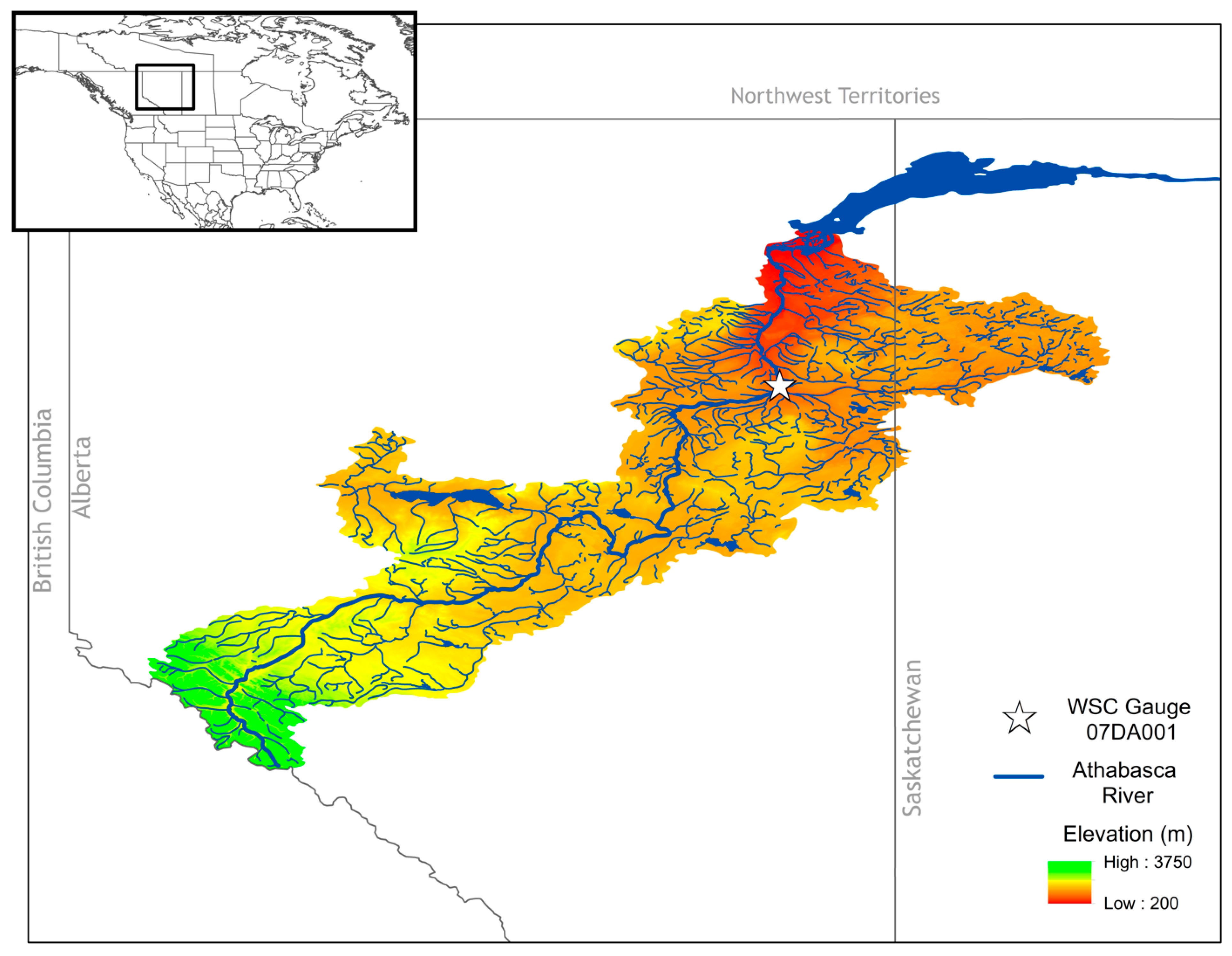
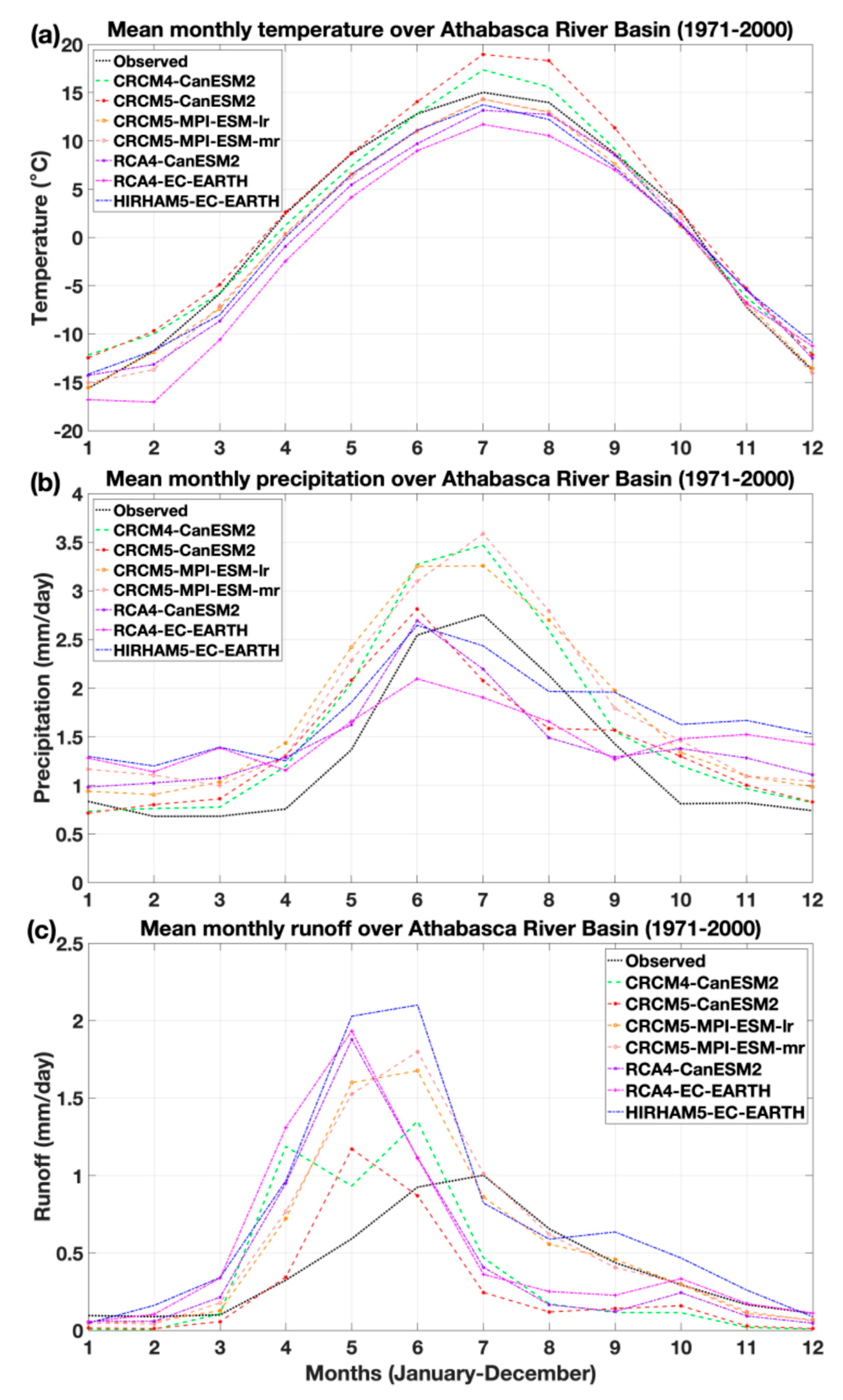
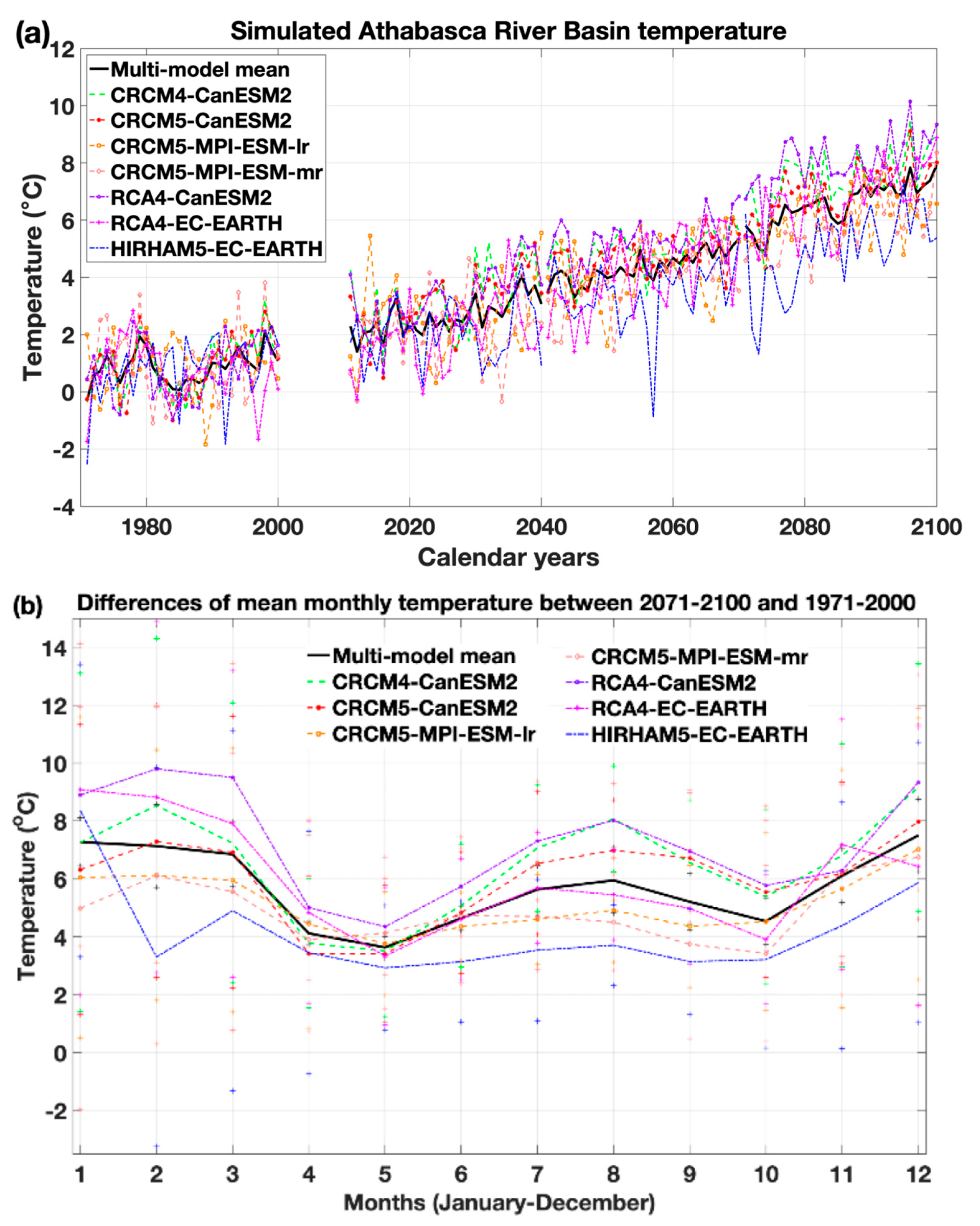
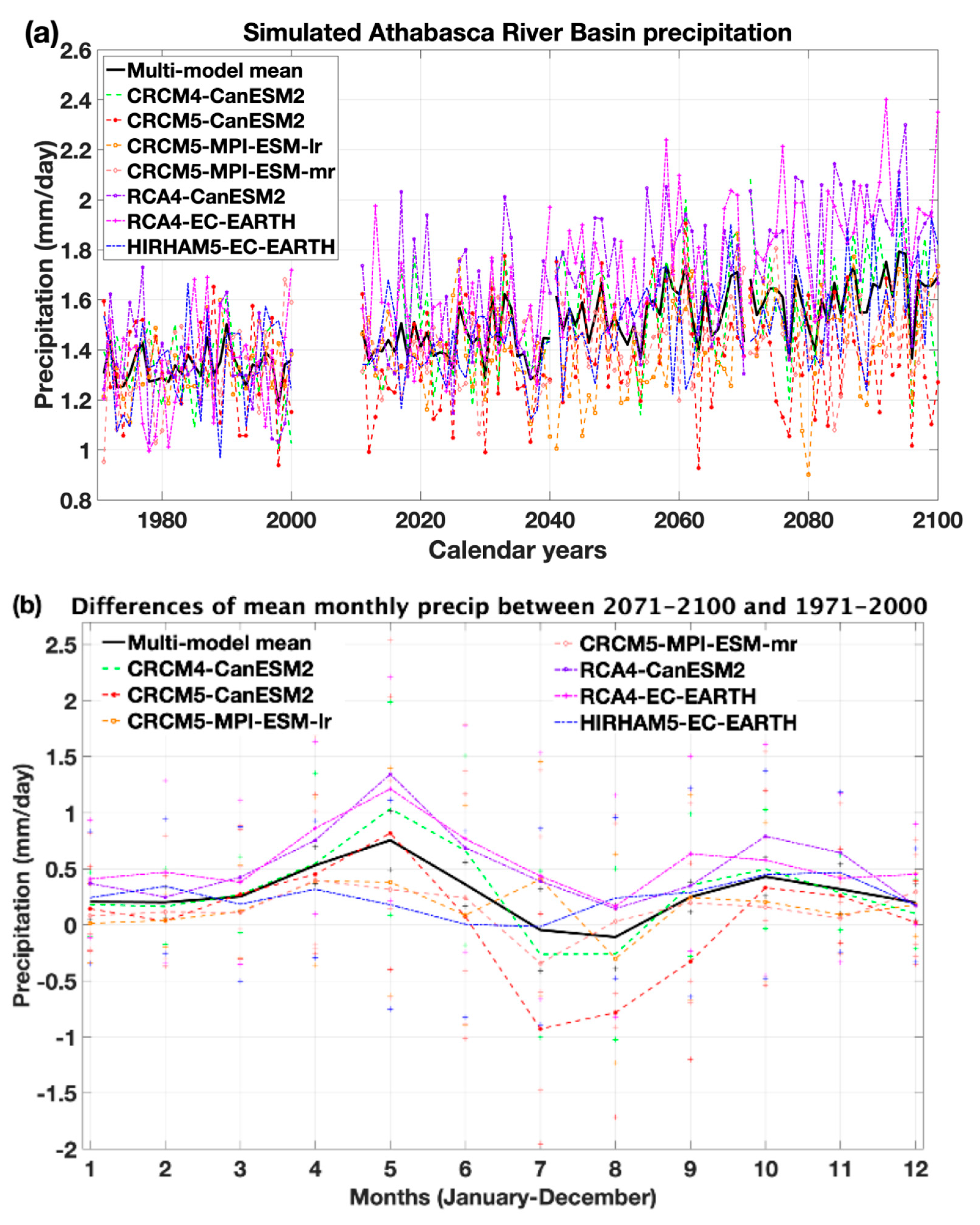
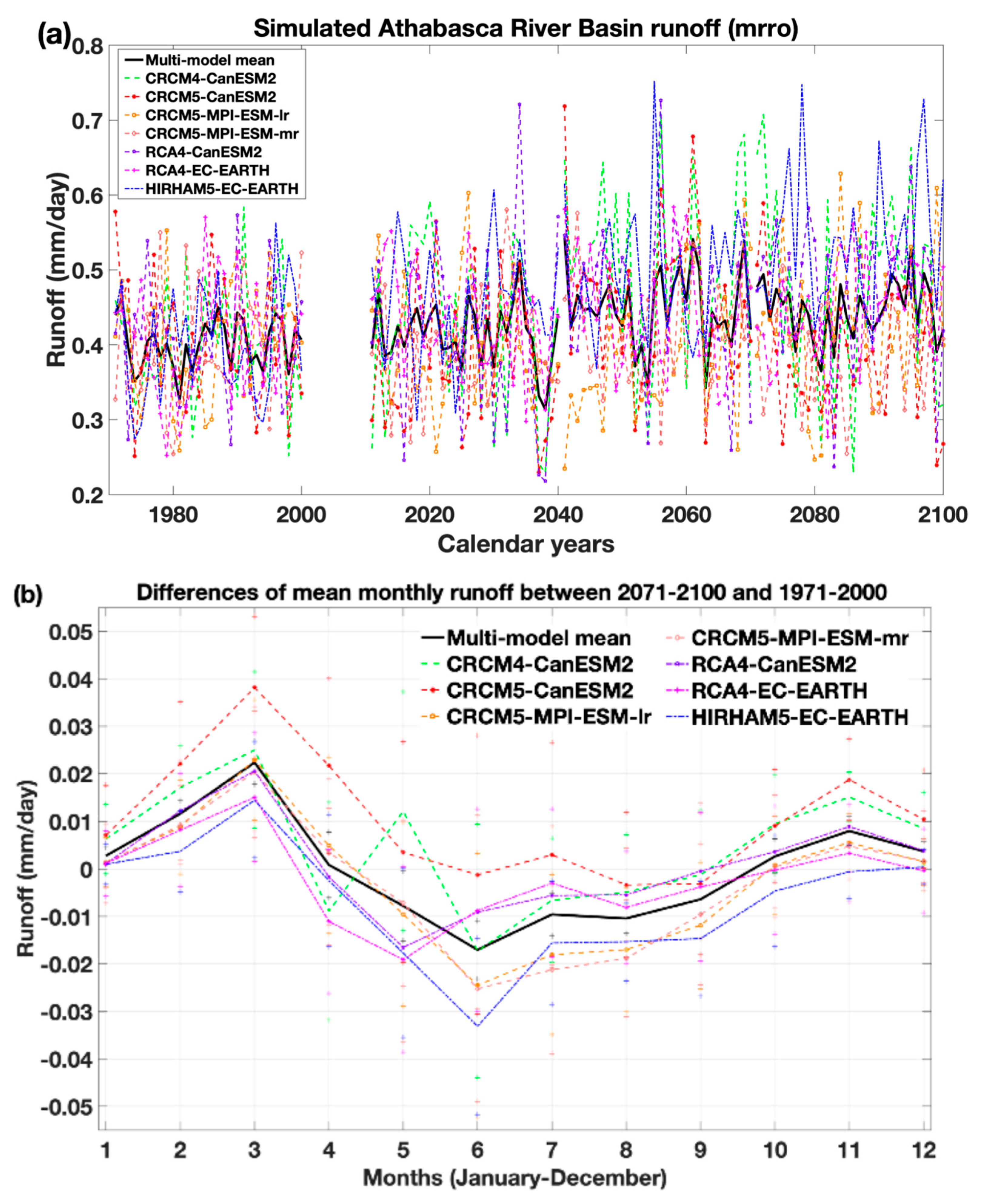


| RCM | ||||||
|---|---|---|---|---|---|---|
| CRCM4 | CRCM5 | RCA4 | HIRHAM5 | Acronym for RCM-GCM Pair | ||
| G C M | CanESM2 | X | X | X | CRCM4-CanESM2, CRCM5-CanESM2, RCA4-CanESM2 | |
| MPI-ESM-lr | X | CRCM5-MPI-ESM-lr | ||||
| MPI-ESM-mr | X | CRCM5-MPI-ESM-mr | ||||
| EC-Earth | X | X | RCA4-EC-EARTH, HIRHAM5-EC-EARTH | |||
| RCM/GCM | Temp MSE | Temp R | Precip MSE | Precip R | Runoff MSE | Runoff R |
|---|---|---|---|---|---|---|
| CRCM4-CanESM2 | 2.64 | 0.991 | 0.178 | 0.982 | 0.145 | 0.602 |
| CRCM5-CanESM2 | 5.24 | 0.992 | 0.167 | 0.844 | 0.113 | 0.588 |
| CRCM5-MPI-ESM-lr | 1.71 | 0.998 | 0.296 | 0.965 | 0.148 | 0.803 |
| CRCM5-MPI-ESM-mr | 1.80 | 0.997 | 0.310 | 0.981 | 0.153 | 0.842 |
| RCA4-CanESM2 | 4.54 | 0.989 | 0.173 | 0.875 | 0.233 | 0.483 |
| RCA4-EC-EARTH | 12.39 | 0.975 | 0.312 | 0.839 | 0.291 | 0.422 |
| HIRHAM5-EC-EARTH | 3.29 | 0.993 | 0.325 | 0.928 | 0.337 | 0.718 |
| Model ID | Temperature (°C) | Precipitation (mm/day) | Runoff (mm/day) | |||||||||
|---|---|---|---|---|---|---|---|---|---|---|---|---|
| avg. diff. | σhist | σproj | var. ratio | avg. diff. | σhist | σproj | var. ratio | avg. diff. | σhist | σproj | var. ratio | |
| CRCM4-CanESM2 | 6.54 | 0.98 | 1.05 | 1.16 | 0.31 | 0.14 | 0.22 | 2.24 | 0.10 | 0.08 | 0.12 | 4.59 |
| CRCM5-CanESM2 | 6.01 | 0.98 | 0.91 | 0.86 | 0.04 | 0.18 | 0.20 | 1.30 | −0.03 | 0.08 | 0.08 | 0.68 |
| CRCM5-MPI-ESM-lr | 5.15 | 1.02 | 0.88 | 0.74 | 0.17 | 0.12 | 0.21 | 3.06 | 0.01 | 0.08 | 0.10 | 1.52 |
| CRCM5-MPI-ESM-mr | 4.90 | 1.26 | 1.08 | 0.73 | 0.14 | 0.17 | 0.16 | 0.89 | −0.01 | 0.08 | 0.06 | 1.08 |
| RCA4-CanESM2 | 7.25 | 1.02 | 1.00 | 0.96 | 0.53 | 0.19 | 0.23 | 1.54 | 0.18 | 0.08 | 0.09 | 2.49 |
| RCA4-EC-Earth | 6.02 | 1.01 | 1.14 | 1.28 | 0.57 | 0.20 | 0.20 | 1.02 | 0.07 | 0.08 | 0.07 | 1.12 |
| HIRHAM5-EC-Earth | 4.16 | 1.14 | 1.41 | 1.52 | 0.25 | 0.17 | 0.21 | 1.50 | 0.07 | 0.07 | 0.09 | 1.56 |
| Multi-model mean | 5.72 | 0.55 | 0.74 | 1.79 | 0.29 | 0.07 | 0.11 | 2.60 | 0.04 | 0.03 | 0.04 | 1.36 |
| Model ID | CMI (cm) | SPEI | ||||||
|---|---|---|---|---|---|---|---|---|
| avg. diff. | σhist | σproj | var. ratio | avg. diff. | σhist | σproj | var. ratio | |
| CRCM4-CanESM2 | −1.18 | 0.71 | 1.24 | 3.00 | −1.15 | 0.59 | 0.78 | 1.78 |
| CRCM5-CanESM2 | −1.96 | 0.74 | 1.07 | 2.07 | −1.80 | 0.55 | 0.59 | 1.14 |
| CRCM5-MPI-ESM-lr | −1.08 | 0.54 | 1.00 | 3.37 | −1.39 | 0.47 | 0.84 | 3.16 |
| CRCM5-MPI-ESM-mr | −1.07 | 0.74 | 0.72 | 0.92 | −1.06 | 0.56 | 0.60 | 1.08 |
| RCA4-CanESM2 | 0.23 | 0.77 | 1.13 | 2.13 | 0.15 | 0.62 | 0.64 | 1.07 |
| RCA4-EC-Earth | 0.61 | 0.92 | 0.73 | 0.63 | 0.47 | 0.64 | 0.53 | 0.68 |
| HIRHAM5-EC-Earth | −0.37 | 0.66 | 0.74 | 1.26 | −0.50 | 0.58 | 0.57 | 0.96 |
| Multi-model mean | −0.69 | 0.31 | 0.52 | 2.68 | −0.76 | 0.27 | 0.32 | 1.39 |
Disclaimer/Publisher’s Note: The statements, opinions and data contained in all publications are solely those of the individual author(s) and contributor(s) and not of MDPI and/or the editor(s). MDPI and/or the editor(s) disclaim responsibility for any injury to people or property resulting from any ideas, methods, instructions or products referred to in the content. |
© 2025 by the authors. Licensee MDPI, Basel, Switzerland. This article is an open access article distributed under the terms and conditions of the Creative Commons Attribution (CC BY) license (https://creativecommons.org/licenses/by/4.0/).
Share and Cite
Brault, M.-O.; St-Jacques, J.-M.; Andreichuk, Y.; Gurrapu, S.; Pace, A.V.; Sauchyn, D. Projected 21st Century Increased Water Stress in the Athabasca River Basin: The Center of Canada’s Oil Sands Industry. Climate 2025, 13, 198. https://doi.org/10.3390/cli13090198
Brault M-O, St-Jacques J-M, Andreichuk Y, Gurrapu S, Pace AV, Sauchyn D. Projected 21st Century Increased Water Stress in the Athabasca River Basin: The Center of Canada’s Oil Sands Industry. Climate. 2025; 13(9):198. https://doi.org/10.3390/cli13090198
Chicago/Turabian StyleBrault, Marc-Olivier, Jeannine-Marie St-Jacques, Yuliya Andreichuk, Sunil Gurrapu, Alexandre V. Pace, and David Sauchyn. 2025. "Projected 21st Century Increased Water Stress in the Athabasca River Basin: The Center of Canada’s Oil Sands Industry" Climate 13, no. 9: 198. https://doi.org/10.3390/cli13090198
APA StyleBrault, M.-O., St-Jacques, J.-M., Andreichuk, Y., Gurrapu, S., Pace, A. V., & Sauchyn, D. (2025). Projected 21st Century Increased Water Stress in the Athabasca River Basin: The Center of Canada’s Oil Sands Industry. Climate, 13(9), 198. https://doi.org/10.3390/cli13090198






